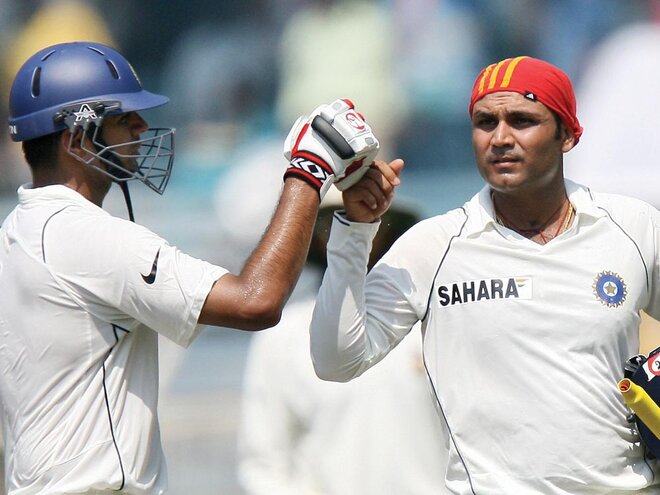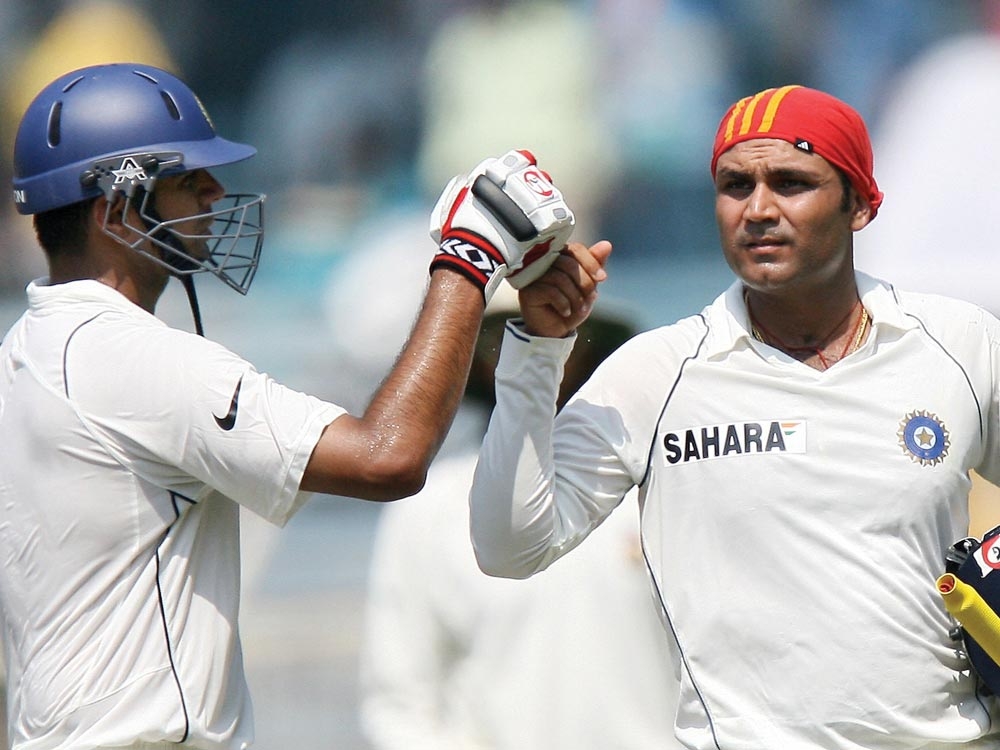
Consistent compounding requires focus and discipline over long periods of time. However, just like assembly-line workers in a manufacturing process may find themselves bored by the repetitive nature of their work, consistent compounders also run the risk of boredom/fatigue/complacency in the long run. This can then lead to mistakes caused by either (a) lethargy in the face of evolutions, disruptions and changing competitive environment or (b) capital misallocation. So how can investors figure out whether a great company is gradually becoming lethargic? I joined forces with two of my colleagues, Rakshit Ranjan and Deven Kulkarni, to investigate. The summary of our research is outlined in this article.
Rahul Dravid: The consistent compounder of cricket
In cricket, the 'boring' Rahul Dravid has beaten the 'flamboyant' Virendra Sehwag in batting averages across all formats of the game (see exhibit below). Not only this, the outperformance of Rahul Dravid over Virendra Sehwag is wider for the shorter formats of the game - a counter-intuitive outcome given that shorter formats intuitively offer more room for 'excitement' compared to test cricket.
"Test cricket, he often says, is such a fulfilling experience because it challenges the mind continuously for four or five days. Dravid belongs to that priceless breed of champions whose mental resolve is at its strongest when the situation is dire." ... "Dravid's batsmanship was often taken for granted because it was so firmly rooted in time-worn traditions - leaving the good balls, not hitting in the air or on the up, and because it was so utterly comprehensible and lacking in mystique. But only those who have played the game at the highest level can fully appreciate the true meaning of Dravid's craft."
- Sambit Bal, Editor of ESPN Cricinfo in the book 'Rahul Dravid: Timeless Steel - Collected writings on Indian cricket's go-to man' (2012)
Risk of lethargy is a key risk for Consistent Compounders
"Loss of focus is what most worries Charlie [Munger] and me when we contemplate investing in businesses that in general look outstanding. All too often, we have seen value stagnate in the presence of hubris or of boredom that caused the attention of managers to wander."
- Warren Buffett in his 1996 annual letter
While driving a car on 'cruise control', fatigue and a false sense of security can lead to lack of attention and an accident. When it comes to both equity investing as well as business management, the philosophy of 'consistent compounding at a healthy pace' requires an investor or a management team to focus only on their core strengths in a disciplined and sustainable manner over a long period of time. Although this sounds too simple and traditional, it is one of the hardest characteristics to develop, partly because consistent compounding over the longer term tends to get monotonous or boring, especially when the external environment offers 'exciting' opportunities. As a result, investors in these firms run the risk of their management teams either doing too little to sustain their competitive advantages or doing too much by chasing exciting opportunities aggressively. In both of these scenarios, the management loses its focus on core strengths (in cricketing parlance, after a long and successful innings, the batsman either gets clean-bowled out of fatigue or gets caught while hitting the ball on the up out of excitement).
Our 'Lethargy Test' framework
This framework focuses on identifying the following signs of lethargy/complacency/indiscipline using secondary data research (annual reports, quarterly management commentary) as well as primary data checks (e.g., extensive discussions with ex-employees, channel partners, raw-material vendors, customers, IT and HR consultants):
Lack of incremental deepening of moats: Over time, a Consistent Compounder faces three key risks - competition, disruption and evolution:
- Competition: Our portfolio companies operate in large industries and generate high returns on capital employed. Hence, they always attract competitors who try to narrow down the gap between return on capital and cost of capital for these companies. Such competitors could try to either replicate the offerings of our portfolio companies or get into a price war or attempt to introduce a new way of catering to the requirements of various stakeholders (customers/ channel partners/raw material vendors, etc).
For instance, in 2019, JSW Paints entered the paints industry with 'any colour one price' offering. In 2017-18, Van Heusen (Aditya Birla Fashion and Retail) launched premium innerwear to compete directly with Jockey by offering higher incentives to distribution channel partners. Dr Lal PathLabs faced a massive price war from competitors like Thyrocare in 2017.
Reactive research of understanding the response of our portfolio companies to such competitive action is important, but not sufficient. Our lethargy tests proactively aim to understand how our portfolio companies are deepening their competitive advantages, strengthening ties with various stakeholders and refreshing their offerings so as to leave no room for a competitor to take away market share through such actions.
For instance, in addition to speaking to dealers post facto about JSW Paints' aggressive entry into decorative paints, our lethargy tests done in the years prior to such competitive changes have to understand whether Asian Paints has left enough room for any new entrant to make a successful entry into the sector.
- Disruptions: Over the past few years, event-based disruptions like GST, demonetisation, financial crisis (e.g., IL&FS, Global Financial Crisis), COVID-19 crisis have become very frequent. On the other hand, there are several disruptions caused by new technology or new infrastructure (digital or physical) to meet a customer's requirement. Consistent Compounders typically use such disruptions to consolidate the dominance of their franchise by benefitting from the challenges faced by their competitors through such disruptions. Our lethargy tests try to keep a close track of the attempts made by our portfolio companies during periods of disruption. For instance, it has been a fascinating journey over the past four months to watch our portfolio companies take initiatives which will help them gain substantial market share from their peers on the other side of the COVID-19 crisis. Hence, in-depth lethargy tests carried out for our portfolio companies through the previous as well as the current crisis have helped us stay invested with broadly the same portfolio of stocks over the past four months and in fact, buy more of companies whose stock prices had fallen the most during the crisis.
- Evolution: As time progresses, there will be changes in customers' preferences, India's demographics, scale of operations of our portfolio companies, and penetration levels of the products and services of our portfolio companies in existing geographies, etc. Our lethargy tests try to measure how alive, awake and adaptive are the business models of our portfolio companies to such evolutionary changes so as to ensure that they sustain the longevity of earnings growth in their business in future. This includes new product launches, marketing campaigns, IT initiatives to improve operating efficiencies, and investments in systems and processes to help institutionalise processes and manage growing scale of operations.
- The risk of capital misallocation: As Consistent Compounders grow and deepen their competitive advantages, the quantum of free cash flow available for redeployment tends to far exceed the amount that can be reinvested to grow the core business further. Promoters with aspirations of 'empire-building' or those who want to add to their business new revenue growth drivers for the longer term tend to use surplus capital to diversify across geographies or product categories. This could either be organic or inorganic diversification. Many firms prefer the inorganic route towards diversification, acquiring companies in related or unrelated businesses, forging joint ventures with other companies, acquiring minority stakes in other companies, etc. Whilst all this sounds straightforward, many firms with a great core franchise that consistently generates high ROCE have found it difficult to sensibly allocate surplus capital to diversify their business in the past. Hence, our lethargy tests focus substantially on capital-allocation decisions taken by a firm on an ongoing basis.
Saurabh Mukherjea is the CIO at Marcellus Investment Managers and the author of 'The Victory Project:
Six Steps to Peak Potential'.


__w1000__h564__.jpg)
